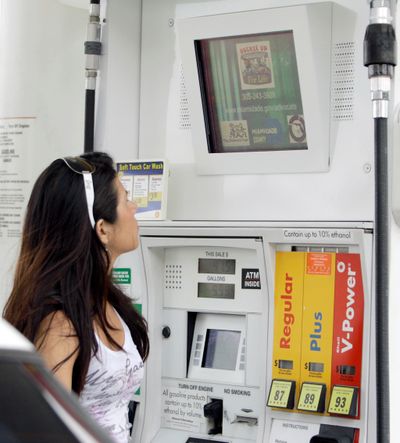Televisions at gas pumps distract from fueling pain

MIAMI – In the midst of a cruel summer for America’s drivers, there’s a diversion: TV at the gas station.
The number of televisions atop gas pumps has skyrocketed since their introduction at a handful of stations in 2006. Now, three privately held companies have placed more than 20,000 screens at thousands of stations from Massachusetts to Southern California.
“We try to bring some fun to the pump,” says Roy Reeves, vice president of sales and marketing for PumpTop TV, an Irvine, Calif., company that provides screens and content at nearly 600 stations nationwide.
Fun at the pump. When was the last time you heard someone say that?
The TVs are also bringing in added revenue for gas retailers, who have recently seen their margins shrink because of an increase in fuel load costs and credit card fees. When the owners advertise anything from candy bars to car washes on the TVs, they say in-store sales rise compared to other stations without the screens.
Gas Station TV says that in tracking its retailers’ sales, stores with screens installed on pumps report selling 75 percent more car washes and 69 percent more snacks if those items are advertised. The other two pump TV companies report similar sales increases.
“I actually have several customers a day saying, ‘Hey, I saw your ad on TV as I was pumping gas,’ ” said David Yegenian, who has eight screens at his Tustin, Calif., service station. “In this difficult time, we have to make ends meet however possible.”
TV programming at the pumps varies by location and provider. PumpTop TV, for instance, provides real-time traffic maps, local sports scores, headlines and weather. Fuelcast carries trivia and NBC content. Gas Station TV broadcasts CBS programming and carried an American Idol-type search earlier this year for a host who will anchor some segments.
All offer heavy rotations of 15-second ads – oil companies are staple advertisers – and all pump “networks” say they will roll out more screens in new markets later this summer. None have released revenue figures, but all say they are growing.
These companies pay gas station owners “rent” in exchange for placing the flat screens above the pumps, and the retailers also can advertise specials or products inside the convenience store.
Once a customer starts the pump, the TV comes on – and stays on. There’s no way to change the channel or mute the volume. So people usually tune in.
“It’s a natural pause point in people’s day,” said David Leider of Gas Station TV, which is based in Detroit. “The customer is tied to the screen with an eight-foot rubber hose for five minutes.”
It also appears that people remember what they see on the pump TVs: according to a Gas Station TV and Nielsen Media Research study, 70 percent of the people who watched the ads remembered the products advertised, and 89 percent of consumers surveyed were willing to buy a product after seeing an ad atop the pump.
“You can push people into the store,” says John McLean, CEO of Fuelcast, which is based in Santa Monica, Calif.
On a recent day at a Shell station in Miami, the Fuelcast screen above the pump aired 15-second ads for fuel-efficient Chevy cars, Norwegian Cruise Lines, and, of course, Shell gasoline.
Anna DaSilva, a 59-year-old retiree from Doral, Fla., said she had never seen the screens at gas stations until this month, when she fueled up at a Shell station near her home. DaSilva said she liked the idea not because of the ads but because it distracted her from the high gas prices.
“I think that’s the whole purpose of the TVs,” she said.